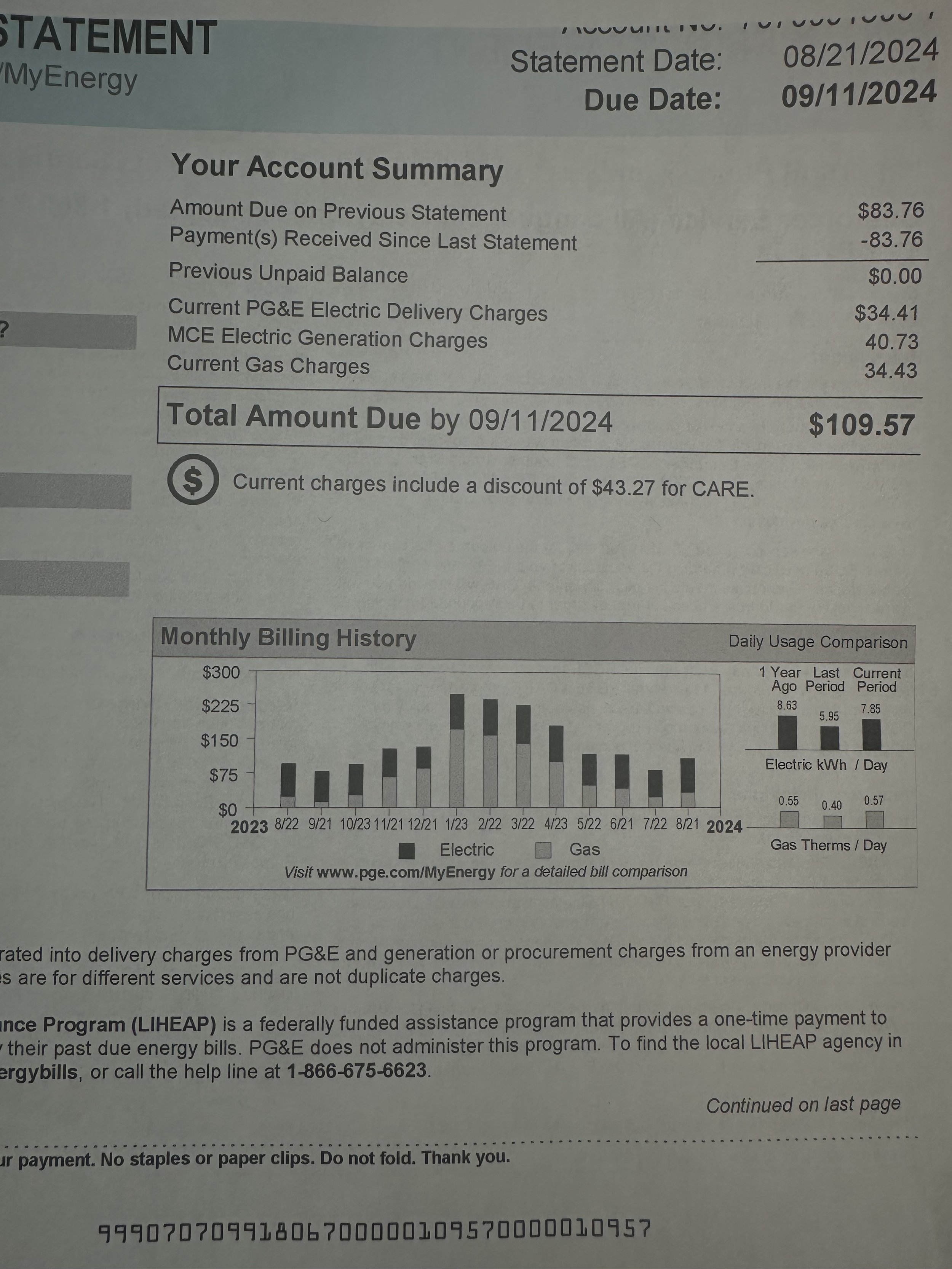California Utilities' New Fixed Charges: What It Means for Solar Customers and Your Energy Bill
/PG&E Bill
In a recent decision that’s been met with mixed reactions, California’s major investor-owned utilities (IOUs) – Pacific Gas & Electric (PG&E), Southern California Edison (SCE), and San Diego Gas & Electric (SDG&E) – have announced a significant change to their pricing structure, with a new monthly fixed charge that will impact customers across the state. The move comes as part of the California Public Utilities Commission's (CPUC) efforts to balance the growing costs of grid maintenance and energy infrastructure. Let’s take a deeper dive into what this means for consumers and solar customers specifically.
The New Fixed Charge Structure
As of Q4 2025 for SCE and SDG&E, and Q1 2026 for PG&E, customers will see a new monthly charge on their energy bills, which will apply to all customers of the three large IOUs. Here’s a breakdown of the changes:
- $24.15 per month for all three large IOUs
This will be the standard fixed charge that applies to all residential customers, regardless of how much energy they consume.
- $6.00 per month for CARE customers
Low-income customers enrolled in California’s CARE (California Alternate Rates for Energy) program will pay a reduced rate for this new fixed charge.
- $12.08 per month for FERA customers
Customers enrolled in the FERA (Family Electric Rate Assistance) program, which serves middle-income households, will also receive a discounted rate.
While this monthly fixed charge may seem like a small increase at first glance, it can add up significantly over time, especially for customers who are currently benefiting from a more flexible pricing structure based on actual energy usage.
Impact on Solar Customers
For solar customers, this decision raises important considerations. Currently, many solar customers benefit from net metering, where they receive credits for the excess solar energy they produce and send back to the grid. This structure has been a key driver for people adopting solar energy, as it allows them to offset their electricity bills and make their investment in solar more financially viable.
However, with the new fixed charge, solar customers will likely see a shift in the way they are billed. The fixed charge means that regardless of how much energy they use or produce, they will still be required to pay this flat fee each month, which could make solar customers' bills less predictable. In essence, while you might still be saving money with your solar installation, your monthly utility charges won’t drop to zero as easily as before – even if you produce more energy than you consume.
Lower kWh Rates to Offset Increased Fixed Charges
In an attempt to balance the increased revenue from the new fixed charge, the utilities have agreed to lower their per-kWh rates. This means that the cost of electricity usage (based on the number of kilowatt-hours consumed) will decrease slightly:
- PG&E: 4.7 cents per kWh
- SCE: 4.6 cents per kWh
- SDG&E: 6.8 cents per kWh
For solar customers, this might offer a bit of relief on the energy side of the bill, as the cost per kWh will be reduced. However, the benefit might be overshadowed by the new fixed monthly charge, especially for those who rely on high energy usage and are accustomed to more variable costs.
What Does This Mean for the Future of Solar?
The introduction of a fixed charge is likely to prompt more discussions around how solar customers are compensated for their energy contributions to the grid. While the lower per-kWh rates may soften the blow, the increased fixed charge could discourage new solar installations for customers who were previously on the fence about making the jump. The unpredictability of utility bills, coupled with the loss of some savings from net metering, may make it harder for some people to justify the initial investment in solar.
However, for those who are already solar customers, this new fee could further highlight the importance of energy storage. With the ability to store excess energy in batteries like the Tesla Powerwall or other similar products, solar customers can reduce their dependence on the grid and avoid some of the impact of the new fixed charges. By maximizing self-consumption of solar energy, customers can reduce their grid reliance, keeping their utility bills lower despite the fixed charge.
A Call for Action
While the rate adjustments by PG&E, SCE, and SDG&E are certainly a step toward addressing infrastructure needs and sustainability goals, they also underscore the need for more comprehensive solutions to incentivize clean energy adoption. With the fixed charge becoming the new norm, California residents and solar customers may need to rethink how they use and store energy to ensure they still benefit from their solar investments.
We recommend that solar customers consider evaluating their energy usage patterns and invest in home energy storage solutions if they haven't already. By doing so, you can continue to make the most of your solar system, even as the utility pricing structure evolves.
Conclusion
The new fixed charge proposed by PG&E, SCE, and SDG&E marks a significant shift in California’s energy landscape, and it’s a change that will impact all consumers, including those who have made the switch to solar. While lower per-kWh rates may provide some relief, the new fixed charge will likely make solar savings less predictable for many. As we head into 2025 and 2026, it’s more important than ever for solar customers to evaluate their energy needs, consider energy storage options, and stay informed about how these changes might affect their long-term energy costs.
If you're thinking about going solar or need to adjust your current system, now is a great time to talk to a professional who can help you navigate the upcoming changes and maximize the savings from your solar investment.


